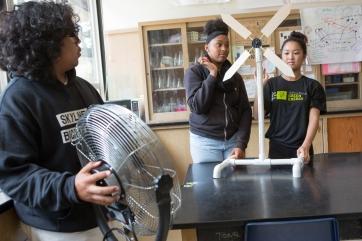Pass the S’Mores – Designing and Evaluating Summer Camps
By Martha Merson and Elise Levin-Güracar, TERC

When we think of summer camp, we think of hot fields, sweaty sports, and swimming in a cold body of water. If we think of conversation, it might be after lights out giggling, not conversations about science identity or college majors, lab work, or whether to collect more data.
However, STEM camps that awaken and nurture interest in science and careers are far more prevalent now than they were in the 20th century. They deliver authentic opportunities to do science in a creative, social way at a range of venues (including labs on college campuses). STEM camp leaders often design these out-of-school experiences with a number of goals in mind, including interest development, knowledge gain, and career exploration; at times introducing youth to ‘real’ scientists or ‘real’ laboratories for the purpose of drawing them into the culture and practices of professional scientists. They design and recruit with an eye to bringing marginalized populations into STEM.
Participants have opportunities to experiment and delve into content that falls outside the standards-based curriculum or to pursue topics that are treated superficially in the classroom in more depth. By definition, these informal educational opportunities promote meaningful activities while avoiding grades, tests, and time constraints found in the typical school day (Gavin & Reis, 2003). The activities may vary or be quite singular in focus. They may or may not mix ages.
We made time to take a look at some STEM summer camps opportunities, evaluation instruments, and reports found in the Community Repository. For anyone planning a STEM summer camp, seeking funding for one, or, like us, who fantasizes about attending or researching impact, there is much to read up on.
We draw on related articles to highlight:
- Design decisions intended to maximize this precious time away from school-year pressures
- Models intended to engage populations who are interested in science, but who are not proportionally enrolled in STEM degrees or participating the STEM focused jobs. One example includes Girlstart.
- Efforts to engage participants with limited vision. Some summer camp providers have found ways to accommodate STEM students according to their abilities (e.g., using a multisensory approach including tactile models and audio cues for youth with visual impairments).
- Surveys and other instruments to assess change among participants
Throughout the literature we reviewed, we read that summer camp programs allow for a safe space for failure, greater risk-taking, and freedom from anxieties related to failure and poor grades. Across the reports and summaries, we also found Gee’s concept of “affinity spaces” influences program design. Affinity spaces (Gee, 2004), are based on common interest in some form of science, people have a common endeavor or interest, enabling those of various skill levels to participate in the same activities, encouraging the development and sharing of specialized knowledge, honoring tacit knowledge, and allowing many different forms of participation and status in the space (Gee, 2004)”. Camp experiences designed around common interest with knowledgeable adults in various roles can facilitate identity and community formation that link youth with larger communities of scientists.
The repository has cataloged 300 entries, so this is just a taste of all you could read and learn from. We hope this article whets your appetite and if you know someone considering starting a program, refining an existing program, or tailoring camp programming for particular audiences youth, including youth with differing needs, you recommend the trove of resources on the repository. We also include information on available research instruments, including interviews and surveys.
Although this article is not a comprehensive look at impact, many evaluation reports address questions of impact. We provide suggestions for further reading.